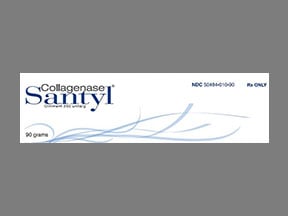
Santyl Coupons & Savings Card – Discount Prices from $327.02
My prescription
Edit
30GM of 250UNIT/GM, Santyl (1 Tube)
Select pharmacy

CVS
$355.76
COUPON PRICE
Walmart
$327.02
COUPON PRICE
Walgreens
$334.46
COUPON PRICE
Albertsons
$345.51
COUPON PRICESantyl savings card
Show this card to your pharmacist
Walmart
$327.02
BIN
ID
PCN
GRP
019876
LH2764D933
CHIPPO
LHX
Powered by
Related collagen-specific enzymes prescriptions
Related collagen-specific enzymes prescriptions
Price history for Santyl
1 Tube, 30GM of 250UNIT/GM
Average retail price for Santyl
Average SaveHealth price for Santyl
Our price history data is based on aggregated prescription data collected from participating pharmacies in America. Our prescription data updates daily to reflect the latest price changes. If you notice a missing data point, it means there wasn't sufficient data available to generate a monetary value for that date.
*Retail prices are based on pharmacy claims data, and may not be accurate when we don't have enough claims.
Santyl dosage forms
Dosage Quantity Price from Per unit 30GM of 250UNIT/GM 1 Tube $327.02 $327.02 30GM of 250UNIT/GM 2 Tubes $673.03 $336.51 30GM of 250UNIT/GM 3 Tubes $1019.04 $339.68
| Dosage | Quantity | Price from | Per unit |
|---|---|---|---|
| 30GM of 250UNIT/GM | 1 Tube | $327.02 | $327.02 |
| 30GM of 250UNIT/GM | 2 Tubes | $673.03 | $336.51 |
| 30GM of 250UNIT/GM | 3 Tubes | $1019.04 | $339.68 |
Santyl Warnings
The safety information below outlines important considerations when using this medication to ensure its effectiveness and minimize risks. Please read carefully and discuss any concerns with your healthcare provider.
- Interaction with Other Topical Products: Be cautious when applying other topical treatments alongside Santyl (collagenase), as they may interfere with its effectiveness. Specifically, avoid using antiseptics containing mercury or silver, such as silver sulfadiazine (SSD), and acidic products on the same area. If these products have been used, thoroughly clean the area with normal saline before applying Santyl (collagenase). It is essential to consult your doctor or pharmacist before using any other topical products concurrently with Santyl (collagenase). Potential risks include interactions with mercury or silver-containing products and those that may alter skin properties.
Santyl Side Effects
When using this medication, some people may experience mild side effects such as pain, a burning sensation, or temporary redness and irritation at the application site. These are generally mild and manageable. If these symptoms persist or worsen, it is important to consult a healthcare provider. To minimize irritation, apply the ointment strictly to the affected area. In rare cases, the treatment can lead to serious complications, such as an increased risk of severe infection (sepsis) when used for burns or skin ulcers. Symptoms of such infections include fever, chills, rapid breathing, fast heartbeat, warm skin, and weakness. These require immediate medical attention. Allergic reactions to this medication can occur, although they are rare. Symptoms may include rash, itching, swelling (particularly of the face, tongue, or throat), severe dizziness, and breathing difficulties. If you experience any signs of an allergic reaction, seek emergency medical help promptly. This list does not encompass all possible side effects. If you notice any other unusual symptoms, contact your healthcare provider for advice.
Santyl Interactions
What is SANTYL Ointment used for?
SANTYL Ointment is used for the debridement of chronic dermal ulcers and severely burned areas. It helps in the removal of dead tissue, promoting the healing of the affected skin.
Can you put Santyl on an open wound?
Yes, Santyl (collagenase) can be applied to an open wound. It is an enzymatic debriding ointment used to help remove dead tissue from wounds, which can promote healing. It is important to follow the healthcare provider's instructions regarding its application and to ensure the wound is properly cleaned before applying the ointment.
Can I buy Santyl over the counter?
Santyl is a prescription medication and cannot be purchased over the counter. It requires a prescription from a healthcare provider.
What are the complications of collagenase ointment?
Collagenase ointment can cause several complications, although they are generally uncommon. Potential complications may include local skin irritation, redness, or a burning sensation at the application site. In rare cases, allergic reactions may occur, which could manifest as rash, itching, or swelling. If any severe reactions or unexpected symptoms occur, it is important to seek medical attention promptly.
What is a good substitute for Santyl?
A good substitute for Santyl, which is a collagenase ointment used for debriding chronic wounds, would depend on the specific needs of the wound and the patient's condition. Alternatives may include other enzymatic debriding agents, such as papain-urea ointments, or mechanical debridement methods. It is important for the patient to consult with a healthcare provider to determine the most appropriate treatment option for their specific situation.
